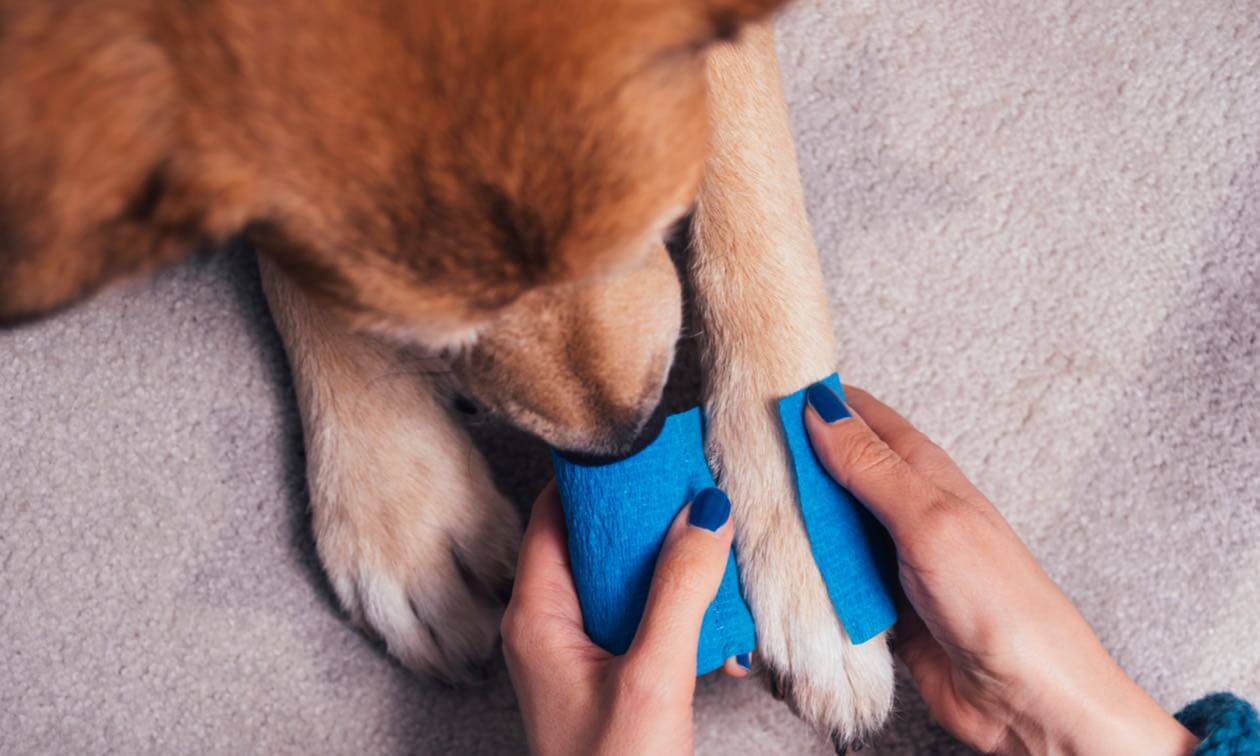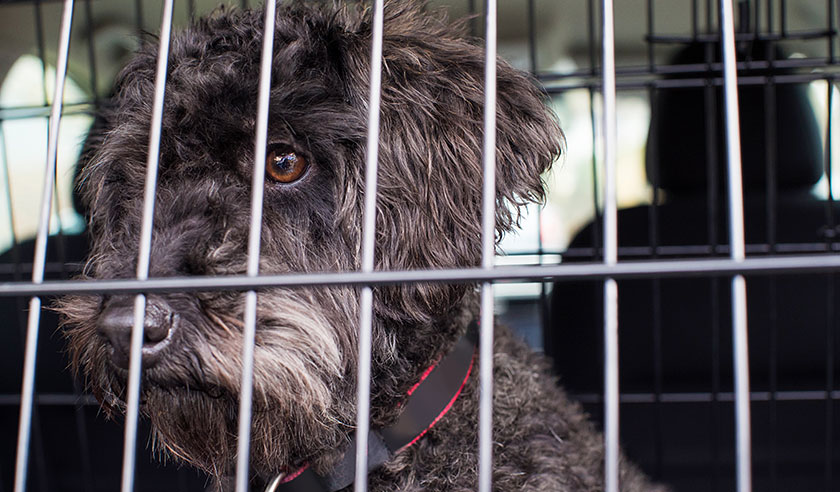Accidents and emergencies happen. Learning basic pet first-aid techniques and having a proper first-aid kit for your dog or cat will help you manage accidents more effectively. Knowing what you can handle at home confidently, what steps to take before seeking veterinary care, and when veterinary care is an emergency is essential for pet owners. In addition to this article, consider taking a cat and dog first aid course such as the Red Cross's "Cat & Dog First Aid Online Training" or a course offered at a local veterinary hospital.
Building a First-Aid Kit for Your Pets
Basic first aid for dogs and cats is essentially the same. The important thing is having the right tools for the job. A pet first-aid kit, filled with the proper items and stored in an easily accessible location, will help you respond calmly in an emergency. Remember to keep the kit out of the reach of children.
Start with a storage box clearly labeled as a pet first-aid kit. The following are some essential items to have in your kit[1].
- Absorbent, non-stick 3" x 3" gauze pads
- Rolled gauze
- Adhesive medical tape
- Self-adhering bandage
- Cotton balls and swabs
- Disposable gloves
- Large and small towels
- Rectal thermometer with lubricant
- Diphenhydramine
- Styptic powder (can use corn starch in a pinch)
- Alcohol or alcohol wipes
- 3% Hydrogen Peroxide (non-expired; DO NOT use in cats or brachycephalic/short-nosed dogs; always consult a veterinarian or animal poison control center before use)
- Antibacterial spray or ointment
- Povidone-iodine or chlorhexidine diacetate (antimicrobial wash)
- Saline wound flush
- Preservative-free saline eye wash
- Artificial tear drops, gel, or ointment
- Sterile lube
- Blunted-ended scissors
- Small battery-powered trimmers
- Tweezers and large forceps
- Magnifying glass
- Hemostats
- Small flashlight
- Instant-cold pack and small hand towel in which to wrap it
- Oral syringe or turkey baster
- Liquid dish soap
- Small bottle of water
- Hypoallergenic dog shampoo
- Soft muzzle
- Leash/collar
- Puppy pads
- Collapsible water bowl
- Corn syrup
Every few months, make sure nothing has expired, batteries are working, and the kit is fully stocked.
Basic Pet First-Aid Precautions
Before beginning any first-aid procedures, take some safety precautions.
- Assess the situation and be sure there are no additional dangers to you and your pet.
- It's recommended to muzzle your pet even if they're normally docile. Use a soft muzzle or gauze (ask your veterinarian to demonstrate). Do not muzzle the pet if they are vomiting as they are more likely to inhale the vomited material if muzzled.
- Keep your pet warm (unless suffering from heat stroke) and quiet while performing treatments.
- Attempt to minimize movement as much as possible if there is trauma, a broken bone, or a neurological issue.
- Call your veterinarian, an animal ER, or, if appropriate, an animal poison control center prior to administering treatment for advice on what to do and how to transport your pet.
Treating Burns on Your Pet
- Cool the burn as quickly as possible. For chemical burns, this can be done by running cool water over the site for 20 minutes. Attempt to keep the rest of your pet dry so they don't get cold. For other burns, wet a washcloth in a mixture of ice and water, wring it out, and place it on the burn. Be sure that your pet is kept warm.
- Avoid touching the area as much as possible.
- Avoid applying any ointments, sprays, or creams.
- Do not apply ice directly to the burn.
- Do not break or burst any blisters.
Call your veterinarian immediately for advice, especially for severe burns. If burns occur to the paws, face, genitals, or are extensive on any part of the body, they are considered serious burns and need medical attention immediately.
Treating a Pet That's Choking
- Remember, your pet is panicking and may bite. Use caution.
- Call your veterinarian or an animal ER immediately for advice.
- Carefully open your pet's mouth and look for any obvious foreign objects. If you see an object, very carefully remove it with hemostats or forceps. Use extreme caution not to push it deeper into the throat or drop your hemostat/forceps into your pet's mouth.
- If your pet collapses or you can't get to the object, lay your pet on their side with their head and neck extended. Then with both hands, apply firm and quick pressure, about 3 to 4 times, to the rib cage. The goal is to create sharp bursts of air from the lungs to dislodge the object.
Treating Your Pet's Bleeding Flesh Wounds
- If the area is bleeding, apply light pressure to the site with a clean gauze pad. Hold this pressure until the bleeding stops — about 3 to 5 minutes.
- If possible, clip the hair surrounding the wound with trimmers. Apply sterile lube over the wound to protect it from accumulating debris as you clip.
- Gently remove the lube and thoroughly flush the wound with sterile saline. Be sure to remove all the dirt and debris.
- Gently dry the area, apply sterile lube, and then bandage the site using clean gauze pads and non-adherent bandage wrap. Take care not to bandage the site too tightly. Remove the bandage and have the area evaluated by your veterinarian if there is swelling or discolored skin around the bandage.
- Seek veterinary care for deep or large wounds, wounds that don't improve within a couple of days, or if your pet is too painful to allow wound care at home.
- Seek veterinary care if your pet seems painful. Do not give over-the-counter pain medications as many are toxic to cats and dogs.
- For superficial wounds or scrapes, clean the site once daily with antibacterial wash and then several times daily apply antibacterial ointment.
- Prevent your pet from licking or chewing the wound site by having them wear a cone or E-collar (Elizabethan collar).
Treating Your Pet's Fight Wounds or Punctures
- Wounds or punctures from fighting should have prompt veterinary attention.
- Since most pets are panicking, in pain and in shock following a fight, use caution. Muzzle your pet, and if possible, wrap them in a towel or blanket.
- Get initial bleeding under control by applying pressure to the site with a clean non-adherent gauze pad as noted above.
- Once the bleeding is controlled, gently flush the wound with sterile saline.
- Apply sterile lube, a gauze pad, and then bandage lightly.
Seek veterinary care. The wound will need proper flushing and additional treatment and your pet may need antibiotics to prevent a deep infection. Your veterinarian can also provide safe pain management options for your pet.
Treating Your Pet's Broken Toenail
If your pet's toenail gets clipped too short or breaks off, the quick (area of the toenail with the nerve and blood supply) can bleed.
- Apply styptic nail powder (or if you don't have any, corn starch) to the bleeding surface and try to keep your pet still for a few minutes until the nail end stops bleeding.
- If the nail or toe develops a bad smell or discharge, or the toe is swollen, red, or painful, seek veterinary care.
If the whole toenail or part of the toenail is torn off:
- Gently flush the area with sterile saline to remove debris and, if bleeding, apply styptic powder and gentle pressure with a clean gauze to stop the bleeding.
- Have your dog seen by your veterinarian. Your veterinarian will determine if any remaining nail fragments need to be removed and provide further treatment.
Toenail injuries are very painful. Your pet may be too painful to safely allow at-home treatment. In this case, take your pet to your veterinarian for initial care. They can give pain medication and sedatives if needed to help lessen your pet's pain and stress for treatment.
Treating Poisoning or Toxin Exposure in Your Pet
Ingestion of or exposure to poisonous substances (cleaning products, rodent poison, antifreeze, etc.) is a true emergency.
If a toxic product gets onto your pet's skin or into their eyes:
- Flush their skin with soap and water.
- Liberally rinse their eyes with sterile saline eye wash.
- Contact a veterinarian immediately following this initial treatment.
If you know or suspect your pet has consumed a potential poison:
- Immediately call ASPCA Poison Control or Pet Poison Helpline. Both hotlines are available 24/7 for poison–related help specific to pets.
- After speaking with a medical professional, attempt to collect samples of any vomit or other materials relating to the toxin.
- Transport your pet to a veterinary facility.
Never induce vomiting without first speaking to a veterinarian and be sure to follow their instructions very carefully.Never induce vomiting if your pet is weak, unconscious, having seizures, or is already vomiting.
Treating Heatstroke in Your Pet
- Immediately get your pet into a shady location.
- Lay their head and back of their neck on a cold towel. Be sure not to cover their mouth, nose, or eyes. Repeatedly remove and wet the towel, so it stays cool.
- If possible, continually pour or run room temperature to lukewarm water over their entire body. Be sure to apply extra to their abdomen and inner thighs. Do not use ice or cold water since it will lower their body temperature too quickly.
- Keep removing the excess water that accumulates on their body as it absorbs the body heat. You can also use a fan to blow air over their body, but take care not to expose electric devices to water.
- Stop cooling your pet when their temperature reaches 102.5 to 103 F. If you don't have a thermometer, you may be able to feel the body temperature is cooler, your pet will be more aware or responsive, and they may pant less. Be careful not to overcool them.
- Get your pet to a veterinarian as soon as possible, even if they appear to be improving.
Treating Seizures in Your Pet
- Create a safe place by removing any objects (chairs, tables, etc.) that may cause injury to your pet. If they're on furniture, make a barrier, so they don't fall off (but do not move or handle them).
- Make sure the area is quiet and dark.
- Do not put your hands or fingers near their mouth.
- Do not attempt to hold or restrain them.
- Try to time the length of the episode. Also, take note of any other things that occur (vomiting, urination, level of alertness, etc.).
- Use caution as your pet recovers from their seizure since they will be fearful and anxious.
- Call a veterinarian during or immediately following the event for treatment and evaluation for underlying causes.
Treating Your Pet's Fractures
If you suspect your pet has a broken bone, they need prompt veterinary care.
- You will need to take precautions since fractures are painful. Before attempting any transportation, gently and carefully place a muzzle on them and cover them with a towel or blanket.
- If you suspect that your pet has a fractured limb, attempt to immobilize it by propping it on a towel or gently placing pillows around it so it won’t move during transport.
- To transport them, you will need a solid flat surface such as a board or a stretcher. A large heavy-duty blanket will work in a pinch. Be sure they are secure to prevent further injury and reduce pain.
Treating Possible Hypoglycemia in Your Pet
If you have reason to suspect your pet has low blood sugar (hypoglycemia), they should receive prompt veterinary care. Young kittens and puppies, and small breed dogs are more prone to low blood sugar if they're not eating well enough to maintain their blood sugar. Certain toxins (such as xylitol artificial sweetener and Sago palm) can cause low blood sugar, as can some medical conditions[2].
The most common signs of low blood sugar are lethargy, weakness, decreased mental awareness (seeming "out of it"), fainting, vomiting, and seizures.
Applying corn syrup to the pet's gums while transporting them for veterinary care can help keep their blood sugar from dropping lower. Your veterinarian will check for low blood sugar and other causes of your pet's symptoms.
Treating A Suspected Allergic Reaction in Your Pet
If your pet suddenly develops swelling of their face, including their muzzle or around their eyes, and/or rashes or bumps (hives) on their body (with or without being very itchy) they may be having an allergic reaction. Some pets will experience such reactions to insect bites or stings, to new food exposures, or to substances in their environment.
- Check with your veterinarian for an appropriate diphenhydramine antihistamine dose for your pet, and have your pet seen promptly by your veterinarian to assess and provide further treatment if needed.
- If your pet has any pre-existing medical conditions or is on any other medications, check with your veterinarian if it is safe to give diphenhydramine.
ZPC-02323
- Create a Pet Poison First Aid Kit. Pet Poison Helpline. https://www.petpoisonhelpline.com/pet-owners/basics/pet-poison-first-aid-kit/. Accessed November 1, 2022.
- Hypoglycemia in Dogs. PetMD. https://www.petmd.com/dog/conditions/systemic/hypoglycemia-dogs. Accessed November 1, 2022.





